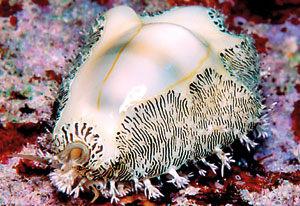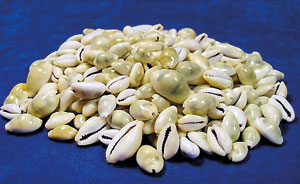“As New Year approaches, there is hardly a household where the rattle of the cowries and the clatter they make when tossed onto the inverted coconut shell, is not heard,” wrote Martin Wickremasinghe in his famous novel, Gamperaliya. The novel says some villagers were so addicted to the game that they began playing Panchi weeks before the Avurudu and continued even after the festive season. Some villagers even gambled their hard-earned money on a game of Panchi.
One wonders how often the clatter of the cowries is heard this Avurudu season even in villages. Perhaps, like the novel Gamperaliya which speaks of the transformation of rural life, the traditional Avurudu has undergone a change with Panchi becoming a lost or vanishing game.
 |
| A live cowry. |
 |
| Money Cowry shells collected after the molluscs
inside have died |
| Pic courtesy www.underwaterkwaj.com |
For an explanation of the game of Panchi, we need look no further than the novel: "Each of the players of two groups alternately took turns to toss the seven lead-filled little cowries, held in the hollow of a small polished coconut shell, onto the polished convex surface of a larger inverted half of a coconut shell. After each toss of the cowries, those that had come to rest with the flat surface upturned scored a point. The points scored by each side were registered by moving one or more of a set of pawns along a pattern of squares outlined on a wooden board, towards a home-base. The first team to take all the pawns to the home base won. Moving the pawns in the most advantageous way and avoiding elimination by pawns of the opponents, requires foresight, experience and shrewdness."
The cowries used in the game are filled with lead to provide additional weight so that they do not spin abruptly.
The ‘Panchi Petha’ -- the board used for the game -- was a household item, mostly in the southern parts of Sri Lanka in earlier times. Wooden boards were used in the olden days, but later cardboard Panchi Petha became popular.
Decades ago when I visited my village for Avurudu, I had the chance to play Panchi. But more than the game, the cowries attracted me. Most of the cowries had a white shell with a yellowish tint, but there were coloured ones too -- some brown and some purple. The shiny shells made a pleasing sound when shaken inside the coconut shell. As children, we collected unbroken Panchi on the beach whenever we visited the seaside. We understood that Panchi was the shell of some sea creature, but knew nothing else.
“Panchi is the shell of a mollusc species called Cowry. It is a kind of sea snail that lives in shallow waters around the country and there are different species,” explained Dr. Malik Fernando, an expert on Sri Lankan sea shells.
The shell of the cowry is indeed the external skeleton or exoskeleton of the marine mollusc made of calcium carbonate. This serves not only for muscle attachment, but also for protection from predators. Ultimately the shell gives a beautiful structure that lasts even after the owner’s death. These cowry molluscs are scientifically classified as the family called Cypraeidae. There are around 250 cowry species in the world’s oceans. Experts believe there can be 20-0 cowry species found in Sri Lankan waters.
Dr. Fernando’s book “Shells of the Sri Lankan Sea Shore” mentions that there are cowries ranging in size from 1cm to 10 cm and the shell of the cowry grows in a spiral fashion like those of other snails until the animal reaches maturity. The shell is usually bordered by teeth on both sides. The exterior is smooth and highly polished. This is because the animal has a covering called a mantle, flesh that wraps around the entire shell. Each animal’s mantle is brilliantly coloured and is often more interesting than the shell itself. The mantle actually has finger-like projections all over it making the shell look like a sponge. When the mantle is touched, the animal withdraws, exposing the shell underneath. This natural camouflage is what makes cowries some of the hardest shells to find when they take refuge in the ecosystem they live.
Divers who often encounter live cowries in the moderately deep water around Sri Lanka, including the ocean around Colombo, claim that the animal is also beautiful like the shells itself. Cowries prefer to take refuge in coral reefs, the underside of boulders and mud-covered rocks where seaweeds abound. They become active only at night. Cowries feed mostly on tiny algae.
“The yellowish white form of the cowry shells usually used in the game of Panchi is the shell of a species called the Money Cowry,” Dr. Fernando said. It gets its name because in ancient times it was used as a form of money. The money cowries are usually smoothly ovate varying from pale whitish yellow to dark yellow with some grey banding across the central portion.
The mantle or the layer of flesh that covers the live Money Cowry is said to be grey-black with yellow streaks and spots. So they would look different on the ocean floor when alive. Because they have a fleshy mantle that covers the shell during the live stage, the shell is protected from predators though some develop mechanisms to penetrate them. Cowries have different ways of hiding from their predators, some burying themselves in the sand while others hide beneath rocks. Their camouflage also makes them hard to spot.
Apart from Money Cowrey, there are other varieties such as Cat or Kitten Cowrie, Grape Cowrie and Arabian Cowrie. So the next time you hear the rattle of a Panchi, spare a thought for the fascinating life of the live cowries that were once in those shiny shells.
|
